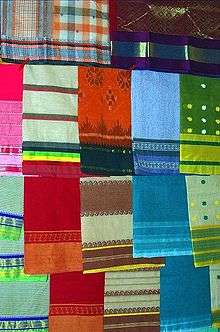Tant sari

Tant saree is a traditional Bengali saree and usually used by Bengali women.[1] It is traditionally made by the weavers from all over West Bengal and Bangladesh but typically few places like Murshidabad, Nadia, Hooghly of West Bengal and Dhaka, Tangail of Bangladesh are famous for tant saree weaving.[2] Since the tant saree are meant for daily use the lowest cost of this saree is ₹350 (US$5.20).[3] Tant saree are woven from cotton threads and distinguished by its lightness and transparency. It is considered to be the most comfortable saree for the Indian hot and humid climate.
History
Under the royal guidance the tant (specially jamdani) and muslin became famous in and around Decca (now Dhaka) in the Mughal era. British government tried to destroy this art to protect the textile industry of Manchester. With the division of Bengal province of British India and departure of British from India many skilled weavers had settled Hoogly, Nadia and Burdwan district of West Bengal with the Government aid and incentive.These weaver made this art famous for West Bengal.[4]
Weaving method
Weaving of tant saree is famous and an age old crafting of West Bengal and Bangladesh. The craftsmen deftly weave the cotton to thread which is woven to tant saree. Two shuttles are used for this purpose. Traditionally, handlooms were used by the weavers, which have today been largely replaced by power looms to weave these sarees.
Themes and motif
The typical Tant saree is characterised by a thick border and a decorative pallav, woven using a variety of floral, paisley and other artistic motifs. Some of the popular traditional motifs are: bhomra (bumble bee), tabij (amulet), rajmahal (royal palace), ardha-chandra (half moon), chandmala (garland of moons), ansh (fish scale), hathi (elephant), nilambari (blue sky), ratan chokh (gem-eyed), benki (spiral), tara (star), kalka (paisley) and phool (flower). Printed, hand-painted and embroidered patterns are also used to get a larger variety of designs.[5] Different motifs including floral element, solar element and recently even modern art are depicted in this saree.[6] Tant Saree comes with colourful design [7] and borders are made thicker because it is subjected to tear easily.
West Bengal chief minister Mamata Banerjee wears tant saree which is brought from Dhaniakhali. This has a typical dimension. This is 6-metre long instead of usual 5.5-metre long saree.[8]
Care
It is recommended that before the first wash, tant sarees should be soaked briefly in warm water mixed with rock salt, to prevent the saree from bleeding colour during subsequent washes. Washing with a mild detergent, followed by starching and then hanging them to dry in a shaded area will ensure the longevity of these cotton sarees.[9]
References
- ↑ Subodh Kapoor (1 July 2002). The Indian Encyclopaedia. Cosmo Publications. p. 6422. ISBN 978-81-7755-257-7. Retrieved 7 November 2012.
- ↑ "A Traditional Panorama - Bengal Art". India Profile. Retrieved 7 November 2012.
- ↑ Mukherjee Pandey, Jhimli (25 May 2011). "The 'Mamata Saree' in hot demand". The Times of India. Kolkata. Retrieved 7 November 2012.
- ↑ "A Traditional Panorama - Bengal Art".
- ↑ "Parinita - tant saree background".
- ↑ "Nutan Fulia Tantubay Samabay samity Ltd.".
- ↑ Bimcy, Sr; Sisily, Sr. Bincy & Sr; Charlotte. Spotlight Social Studies 4. ISBN 81-7172-516-3.
- ↑ Mukherjee Pandey, Jhimli (25 May 2011). "The 'Mamata Saree' in hot demand". Times of India.
- ↑ "Parinita - tant saree care".